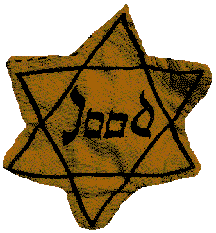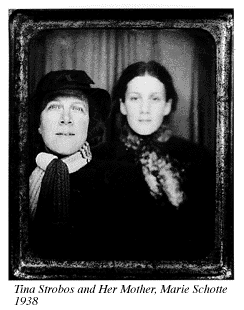TINA STROBOS TELLS HER STORY (Continued)
 TINA STROBOS: I visited many of the people that I hid. Sometimes I was their only contact with the outside world, especially those who were hidden in attics on isolated farms. They generally didn't have much in common with the farmers, and the farmers thought they were pretty odd people, too. Sometimes my mother and I went together, which was a relief, because the visits could be so painful. They couldn't receive mail. A month could go by with no news from anyone. Anything, like mail from a son or daughter, or news, I smuggled to them, which in a way was dangerous. The farmers didn't especially appreciate my visits, and I didn't appreciate having to travel all over the country to make these visits, either. It was hard. Offhand, I would say there were seven people I regularly visited like that.
TINA STROBOS: I visited many of the people that I hid. Sometimes I was their only contact with the outside world, especially those who were hidden in attics on isolated farms. They generally didn't have much in common with the farmers, and the farmers thought they were pretty odd people, too. Sometimes my mother and I went together, which was a relief, because the visits could be so painful. They couldn't receive mail. A month could go by with no news from anyone. Anything, like mail from a son or daughter, or news, I smuggled to them, which in a way was dangerous. The farmers didn't especially appreciate my visits, and I didn't appreciate having to travel all over the country to make these visits, either. It was hard. Offhand, I would say there were seven people I regularly visited like that.
You felt you had to help the children. Everybody felt that, and then too, it was easier to find places for children. For instance, the parents of a little three year-old girl called me. They had a hiding place, but they couldn't bring their child with them. So I said, "Tell me when you're hiding and I'll come pick her up. She can stay in my house until I find a better place for her." I couldn't tell them about our house, that it wasn't really safe.
I would immediately call one of my contacts and say, "On the 18th I will have a visitor, age 3. Can you find a place for her? Let me know." Then we would get a call back. "About that three-year old--we have a place. On the 20th I'll send you instructions on where to bring her." I went to the ghetto and brought her out on my bike. My mother once brought a child home like that, on the back of her bike, without telling me about it.
The trains were still running at that time, so I brought her by train to a farmer. As time passed, this little girl became very attached to her stepmother. The father was caught, but later on when the mother came back, the child no longer recognized her.
It was a very wrenching experience for all of those concerned. Sometimes these farmers didn't want to give up the Jewish children, even though, as in this case, they were blond and the child had dark hair, dark skin, and black eyes. Tamar Melkman was her name; I remember her quite well.
 Once, we had a large family with five children staying with us. They were very religious orthodox Jews, refugees from a small Polish village, who had brought their own bread and food in a big bag. They stayed in their room, leaving only to visit the bathroom. They didn't talk to us. All they wanted from us was water, which we handed to them through the door; they would open it just a crack. They had never met people like us, and didn't quite trust us. I guess they were afraid of heathens, or pagans. We had a few families like that, that had fled Poland or Germany in '39, and stayed with us just a short while. The religious groups had their own network and they would come and go without us knowing who they were, where they were from, or where they were going.
Once, we had a large family with five children staying with us. They were very religious orthodox Jews, refugees from a small Polish village, who had brought their own bread and food in a big bag. They stayed in their room, leaving only to visit the bathroom. They didn't talk to us. All they wanted from us was water, which we handed to them through the door; they would open it just a crack. They had never met people like us, and didn't quite trust us. I guess they were afraid of heathens, or pagans. We had a few families like that, that had fled Poland or Germany in '39, and stayed with us just a short while. The religious groups had their own network and they would come and go without us knowing who they were, where they were from, or where they were going.
 Once, we had a large family with five children staying with us. They were very religious orthodox Jews, refugees from a small Polish village, who had brought their own bread and food in a big bag. They stayed in their room, leaving only to visit the bathroom. They didn't talk to us. All they wanted from us was water, which we handed to them through the door; they would open it just a crack. They had never met people like us, and didn't quite trust us. I guess they were afraid of heathens, or pagans. We had a few families like that, that had fled Poland or Germany in '39, and stayed with us just a short while. The religious groups had their own network and they would come and go without us knowing who they were, where they were from, or where they were going.
Once, we had a large family with five children staying with us. They were very religious orthodox Jews, refugees from a small Polish village, who had brought their own bread and food in a big bag. They stayed in their room, leaving only to visit the bathroom. They didn't talk to us. All they wanted from us was water, which we handed to them through the door; they would open it just a crack. They had never met people like us, and didn't quite trust us. I guess they were afraid of heathens, or pagans. We had a few families like that, that had fled Poland or Germany in '39, and stayed with us just a short while. The religious groups had their own network and they would come and go without us knowing who they were, where they were from, or where they were going.
 TINA STROBOS: I visited many of the people that I hid. Sometimes I was their only contact with the outside world, especially those who were hidden in attics on isolated farms. They generally didn't have much in common with the farmers, and the farmers thought they were pretty odd people, too. Sometimes my mother and I went together, which was a relief, because the visits could be so painful. They couldn't receive mail. A month could go by with no news from anyone. Anything, like mail from a son or daughter, or news, I smuggled to them, which in a way was dangerous. The farmers didn't especially appreciate my visits, and I didn't appreciate having to travel all over the country to make these visits, either. It was hard. Offhand, I would say there were seven people I regularly visited like that.
TINA STROBOS: I visited many of the people that I hid. Sometimes I was their only contact with the outside world, especially those who were hidden in attics on isolated farms. They generally didn't have much in common with the farmers, and the farmers thought they were pretty odd people, too. Sometimes my mother and I went together, which was a relief, because the visits could be so painful. They couldn't receive mail. A month could go by with no news from anyone. Anything, like mail from a son or daughter, or news, I smuggled to them, which in a way was dangerous. The farmers didn't especially appreciate my visits, and I didn't appreciate having to travel all over the country to make these visits, either. It was hard. Offhand, I would say there were seven people I regularly visited like that.